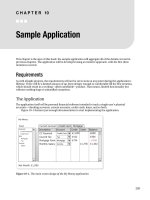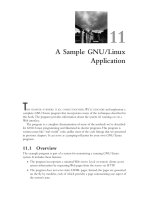Presenting the sample application
Bạn đang xem bản rút gọn của tài liệu. Xem và tải ngay bản đầy đủ của tài liệu tại đây (493.5 KB, 16 trang )
13
■ ■ ■
CHAPTER 2
Presenting the
Sample Application
I
n this chapter, I present you with our sample application, a simple online timesheet. My
aim is to present good working examples of all the topics that we discuss in this book. That
is not to say that every fragment of code that you see in the text will exist somewhere in the
sample application, but rather that all the techniques that I recommend will have their
place in the code. In practice, a code sample is likely to be excluded only where it is illus-
trating a poor practice.
Rationale
I have chosen the online timesheet for the example for several reasons:
• It is a simple concept, familiar to any office worker.
• It translates well into a web-based application.
• It requires a persistent store of data.
• It requires some basic authentication and authorization.
Collectively these features allow me to showcase all of the important features of Spring,
such as the web framework, the integration with the Hibernate persistence framework,
and the Acegi security layer.
Architecture of the Sample Application
I have split the timesheet application into the standard set of layers shown in Figure 2-1.
As well as being an uncontroversial way of slicing up an application, these layers corre-
spond well with the suites of Spring classes that are required to build a web application.
Minter_685-4C02.fm Page 13 Monday, November 5, 2007 6:49 AM
14
CHAPTER 2
■
PRESENTING THE SAMPLE APPLICATION
Figure 2-1.
The layers of the timesheet application implementation
Actually the layers of Figure 2-1 present something of a mixed metaphor, as I have
added two architectural components (the database and mail server) that are not normally
thought of as being application layers in their own right.
The Presentation Layer
The presentation layer of the application includes all of the components that are prima-
rily concerned with presenting the application to the user. The example application has
several presentation aspects to it: the login pages, the user administration pages, and the
timesheet management pages. The specific implementation can vary, and Spring is very
accommodating of external standards, but for the sake of simplicity I have implemented
these by using the Spring MVC and Spring Web Flow libraries for the controllers and
JavaServer Pages (JSPs) to render the output (the views). The presentation layer is discussed in
depth in Chapter 6.
The container for the web application that I have used in my examples is Apache Tomcat
version 5.5, which is downloadable from the Apache website at .
You will need to ensure that you have the Tomcat manager application installed (this is
included in the default Tomcat installation) to allow the application build to manage web
application deployments. You also will need to configure an administrative username
and password for the manager application, usually by editing the tomcat-users.xml file in
the conf subdirectory of the Tomcat installation directory.
Minter_685-4C02.fm Page 14 Monday, November 5, 2007 6:49 AM
CHAPTER 2
■
PRESENTING THE SAMPLE APPLICATION
15
The Service Layer
The service layer represents the business logic of the application. All operations from the
presentation layer pass through the service layer. Indeed, ideally the presentation layer is
a relatively thin veneer of functionality on top of the service layer. The service layer is often
exposed to other external mechanisms that need to have direct access to the logic of the
application—for example, an application may make the methods of all or part of the service
layer available via SOAP so that third parties can create their own clients to the system.
The service layer itself is then a combination of business logic and an aggregation of
necessary data access layer components. In my simple timesheet application, this means
that you will see a lot of service layer methods as simple as (or simpler than) the example
in Listing 2-1.
Listing 2-1.
A (Simple) Service Layer Method
public void updateTimesheet(final Timesheet timesheet) {
timesheetDao.update(timesheet);
emailDao.sendTimesheetUpdate(timesheet);
}
This may seem pointless—it’s natural to wonder why the two DAO method calls cannot
be incorporated directly into a presentation layer method—but there are advantages. The
service layer method can be exposed to the outside world without needing to reveal the
existence (and implementation detail) of the two DAOs. And the method provides a simple
place in which to put transactionality. If the timesheet update fails, we don’t want to send
the e-mail, and conversely if the e-mail cannot be sent, we should not update the timesheet.
The issues around building a business service layer and transactionality are discussed
in full detail in Chapter 5.
The Data Access Layer
The data access layer is our interface with underlying data stores. The timesheet applica-
tion limits these underlying components to a single database and a single mail server.
This is not an unrealistic example (many real applications have exactly this structure) but
there are numerous other mechanisms that could be used, such as data-queuing systems
and event-logging systems.
The DAO provides an abstraction of the underlying data source. In principle, an imple-
mentation based around a relational database can be replaced with a flat-file–based
implementation (or vice versa) without any impact on the functionality of the rest of the
application. More realistically, a specific database could be substituted with minimal
impact to the rest of the design.
Minter_685-4C02.fm Page 15 Monday, November 5, 2007 6:49 AM
16
CHAPTER 2
■
PRESENTING THE SAMPLE APPLICATION
The benefits around a possible substitution of implementation can be overstated;
swapping out a database isn’t that frequent an occurrence. The real benefit of introducing
the DAO layer is the way that it constrains certain types of complexity (database operations)
to small classes. This makes debugging much simpler, and this is the advantage of the
layered approach in general. A bug can be readily tracked to the layer it originates in (often
its characteristics will be such that it is easy to infer its origin), and the limited complexity of
the layer then makes analysis of the bug much simpler.
The Database and Mail Server
The two architectural components shown in Figure 2-1 are the database and the mail
server. These are applications in their own right, standing outside your Spring application
implementation.
I have assumed that the mail server is available to you already. If you can send and
receive e-mail, you already have access to one, and I think that is a reasonable assumption
for readers of this book.
The database is another matter. You may have no database readily available or you
may have several. Installing a database (let alone administrating one) can be a complex
task in itself, and I have therefore decided to use the HSQL (previously known as Hypersonic)
embedded database. This can be used in several modes:
• Stand-alone as a network-accessible database manager
• Embedded as an in-memory database
• Embedded as a flat-file–based database
The full documentation for the HSQL database can be obtained from the website at
.
I use the database in only the two embedded modes: in-memory for the benefit of unit
tests (so that the database can be repeatedly created and destroyed without affecting
subsequent tests) and as a flat-file–based database for running the example application.
Because I am using the database in embedded mode, I only need to obtain the library
files in order to configure the database, and I do this by pulling it in as a Maven dependency
(see the “Maven” section later in this chapter) so you don’t need to explicitly download
anything! If you want to use another database that’s already available to you when running
the example application, this is discussed in detail in Chapter 4.
Minter_685-4C02.fm Page 16 Monday, November 5, 2007 6:49 AM
CHAPTER 2
■
PRESENTING THE SAMPLE APPLICATION
17
Specification
You should always have a specification. Without one, you don’t know exactly what you are
building, and many an application goes hopelessly over budget or over deadline or both
because insufficient time was spent specifying what the application actually needed to do.
That is not to say that a specification is set in stone. No project ever emerges with quite
the design that the architect had in mind when he started work. The specification should
be changed as its inadequacies and misconceptions become clear.
This is not a book on design, so the full-blown specification that I worked from in building
the example application would be overkill. Moreover, it has some eccentric requirements,
because they were bent by the need to illustrate architectural detail where the normal
situation is reversed.
Given these constraints, I have limited my specification to a couple of use case scenarios
explaining how a typical user might interact with the site. For information on how a real
specification should be put together, I recommend reading the four-part article “Painless
Functional Specifications” by the always excellent Joel Spolsky in Joel on Software (Apress,
2007) and on his website at .
Scenario 1
Jane is the administrator of the company intranet site. To add a new user, John Strange, to
the application, she goes to the login page and enters the readily guessable default login
details (admin/setec). Upon logging in, she selects the Administration menu option and is
presented with a list of the existing users. She selects the Add New User menu option.
On the resulting Create User page, which you can see in Figure 2-2, she sets the username
(jstrange) and clicks Preview User. She checks that the name has been entered correctly
and clicks the Save User button. Looking at the list, she can see that John’s username has
been added and so she chooses Logout from the main menu.
Figure 2-2.
The Create User page
Minter_685-4C02.fm Page 17 Monday, November 5, 2007 6:49 AM
18
CHAPTER 2
■
PRESENTING THE SAMPLE APPLICATION
Scenario 2
John Strange is new to the company and has been asked to fill in his timesheet for his first
day’s work. Jane has sent him an e-mail with his login details (jstrange/password) and he
enters these into the login page. Upon logging in, he is presented with the (empty) home
page and chooses Manage Timesheets from the menu.
As a new user, he has no timesheets listed on this page, so he chooses Create Timesheet
from the menu. This presents him with the page shown in Figure 2-3.
Figure 2-3.
The Create Timesheet page
He enters a note stating that this is his first timesheet and clicks the Create Timesheet
button. He is returned to the Manage Timesheets page, where his timesheet now appears
in the list. Selecting this timesheet, he can now see his (empty) timesheet. He selects the
Add Period command in order to add his day’s working details. He amends the start and
finish time to match his working day (entering the office at 9 a.m. sharp and leaving at 7 p.m.
in order to look keen on his first day). He adds a note explaining that this is his first day,
and as he is an agency worker sets his rate to $40 an hour (standard pay). He will now see
the updated view of the timesheet shown in Figure 2-4.
Minter_685-4C02.fm Page 18 Monday, November 5, 2007 6:49 AM









